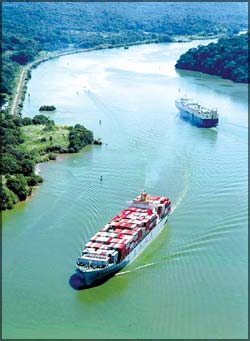
Panama Canal widening now in progress
The excavation and dredging works to enlarge the Panama Canal are
being carried out in different levels of execution, as part of a process
that should conclude in 2014.
The first dry excavation stage, has been fulfilled by almost 90 per
cent.

The second part of the contract, work has been executed by 60 per
cent. The third is still in its initial stage. According to available
reports the value of the already agreed contracts reached about 339.4
million dollars in December.
The programme consists of the construction of two lock complexes,
with three levels each, together with the widening and deepening of the
existing navigation channels in the Gatun Lake and the Atlantic and
Pacific Oceans.
Another dry digging of approximately four miles will be performed to
join the Pacific and Corte Culebra locks. Three consortiums presented
their respective proposals to design and build the new locks of the
Canal. The Panama Canal widening will cost 5.2 billion dollars, of which
3.2 billion dollars will be spent in the locks.
The Panama Canal is a man-made canal which joins the Atlantic and
Pacific oceans. One of the largest and most difficult engineering
projects ever undertaken, it had an enormous impact on shipping between
the two oceans, replacing the long and treacherous route via the Drake
Passage and Cape Horn at the southernmost tip of South America.
A ship sailing from New York to San Francisco via the canal travels
9,500 KM (6,000 miles), well under half the 22,500 km (14,000 mile)
route around Cape Horn.
Although the concept of a canal near Panama dates back to the early
16th century, the first attempt to construct a canal began in 1880 under
French leadership. After this attempt failed and saw 21,900 workers die,
the project of building a canal was attempted and completed by the
United States in the early 1900s, with the canal opening in 1914.
The building of the 77 km (48 mile) canal was plagued by problems,
including disease (particularly malaria and yellow fever) and
landslides. By the time the canal was completed, a total of 27,500
workmen are estimated to have died in the French and American efforts.
Since opening, the canal has been enormously successful, and
continues to be a key conduit for international maritime trade. The
canal can accommodate vessels from small private yachts up to large
commercial vessels.
The maximum size of vessel that can use the canal is known as Panamax;
an increasing number of modern ships exceed this limit, and are known as
post-Panamax or super-Panamax vessels. A typical passage through the
canal by a cargo ship takes approximately 8-10 hours. |

